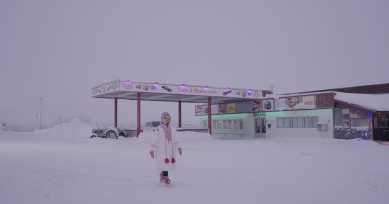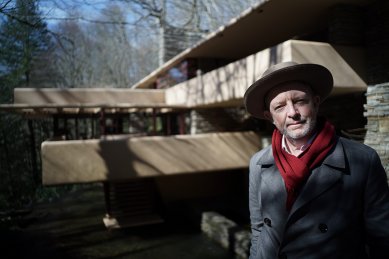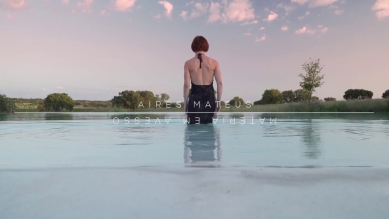
Den architektury 2019 - Film and architecture
The Festival of Architecture Day and its sister festival Film and Architecture invite you to cinemas in the first week of October. This is not only for an extraordinary collection of films by foreign and Czech creators dedicated to architecture, urbanism, and design but also for excursions to both disappeared and current cinemas in Prague.
The Film and Architecture Festival reflects current themes, phenomena, or problems of contemporary architecture and urbanism. Feature films, complemented by short experimental or author films, will be screened at fifteen locations across the country, including Prague, Brno, Ostrava, Hradec Králové, and Pardubice. Just like the Festival of Architecture Day, the program intertwines themes of Free Architecture and Bauhaus, which celebrates its 100th anniversary this year. Visitors can also look forward to documentaries about architects Frank Lloyd Wright and Bohuslav Fuchs or the most famous industrial designer of today, Dieter Rams. Additionally, there will be a film documenting the last old neighborhood of one of the most populous cities in China, Chongqing, or a documentary sensitively connecting the world of longtime residents, tourists, and businesspeople in Venice. In some cases, films will be screened with the participation of their authors.
On September 19, 2019, the organizers invite you to a so-called festival Warm-up at the Světozor cinema, where the Danish film The Human Shelter will be presented with the participation of Jord den Hollander, an architect, filmmaker, and chief curator of the Architecture Film Festival Rotterdam, and promoter of architecture Adam Gebrian. The film will then embark on a short tour to other cinemas across the Czech Republic. On October 6, the film will be screened in Prague once again, this time with the personal participation of director Boris Bertram. The film experiment The Human Shelter resonates perfectly with the current social mood in the world. The director seeks answers to the simple question of what home means to us. Different forms and shapes of human dwellings are explored in the film across four continents. Following the opening screening, on September 20, there will be a standalone lecture by Jord den Hollander at CAMP on the topic of Cycling Cities.
The complete program is available at www.filmarchitektura.cz and www.denarchitektury.cz. Foreign-language films are always screened with Czech or English subtitles. The festival is intended for the general public across generations with an interest in architecture, urbanism, design, and art.
The program of the Film and Architecture Festival, which will head to cinemas between October 1 and 7, has several thematic blocks. The theme of free architecture builds on the main theme of the parent Architecture Day this year: 30 years of life in freedom. The year 1989 brought the opportunity for truly free creative expression, which requires free thinking that is not bound by conventions, prejudices, or stereotypes. The buildings, architects, and users of architecture featured in the festival perfectly represent this freedom. This includes the film Aires Mateus: Matter in Reverse, in which the famous Portuguese architect reflects on the role of architecture. He speaks about its fundamental principles and values, as well as what fascinates him about it. The Proposal is the first feature documentary and conclusion of the extensive project The Barragán Archives, in which American artist Jill Magid explores the contested legacy of the most famous Mexican architect, Luis Barragán.
In the American documentary Frank Lloyd Wright: The Man Who Built America, Welsh architect Jonathan Adams visits several famous buildings designed by a man many consider the greatest architect in the history of the USA to uncover the secrets of his organic architecture. Another monographic documentary is the Czech film European Architect Bohuslav Fuchs, which summarizes the historical and contemporary significance of Bohuslav Fuchs's work both domestically and abroad. It thus presents one of the founders of the unique tradition of Brno functionalism, among whose most significant buildings in Brno are Zeman's café and the Avion hotel.
The thematic section Faces of Cities presents cities of various forms, sizes, ambitions, and problems, primarily through personal testimonies of people who live in them. In the documentary Last Days in Shibati, director Dusollier spent several months in the last old quarter of the third largest and most populous city in China, the fifty-million Chongqing, to capture everyday life in a place threatened with demolition. The film This Cold Life is dedicated to the lives of people in the harshly natural surroundings of the Svalbard town of Longyearbyen and the only resident of the abandoned mining town of Pyramiden. The Italian documentary The Venice Syndrome, selected for the festival by Adam Gebrian, presents romantic Venice full of cozy corners and charming canals in contemporary reality and without illusions. It captures the ongoing cultural and social decline of Venice through the mass tourism of the 21st century, sensitively connecting the world of longtime residents, tourists, and businesspeople in the fight for a place in the sun.
The 100th anniversary of the founding of the Bauhaus will be marked by the documentary Vom Bauen der Zukunft, which describes the fascinating history of this school and places it in the context of our current cultural development. Through interviews with many experts, it proves that the spirit of the Bauhaus lives on. The Spanish documentary Mies on Scene. Barcelona in Two Acts documents the creation and reconstruction of the German Pavilion in Barcelona, designed by Mies van der Rohe and Lilly Reich. The American film Rams presents one of today's most famous industrial designers, Dieter Rams, known for his statement “Less but better,” referring specifically to Bauhaus. The music for the film was composed by Brian Eno.
An interesting perspective on the connection between architecture and film will be provided by an engaging walk on Sunday, October 6, Through Disappeared Cinemas, with journalist Josef Vomáčka, leading through the most cinema-rich area of the First Republic - the area around Wenceslas Square, National Avenue, and Perštýn. It will recall all the cinemas that were gradually established, operated, and, unfortunately, eventually disappeared.
The entire festival will conclude on October 7 at the Světozor cinema with a special evening combining silent film and electronic music. In the mysterious thriller by director Robert Wiene, The Cabinet of Dr. Caligari from 1920, architecture influences all film elements: visual, acting, and scenographic. A live musical accompaniment by the Ostrava-based group FORMA will provide viewers with an extraordinary cinematic experience. The film is part of the established section Archi.kult, which always presents one representative who has prominently marked history. Before the screening, interested parties can participate in a tour of the Světozor cinema.
More information >
The Film and Architecture Festival reflects current themes, phenomena, or problems of contemporary architecture and urbanism. Feature films, complemented by short experimental or author films, will be screened at fifteen locations across the country, including Prague, Brno, Ostrava, Hradec Králové, and Pardubice. Just like the Festival of Architecture Day, the program intertwines themes of Free Architecture and Bauhaus, which celebrates its 100th anniversary this year. Visitors can also look forward to documentaries about architects Frank Lloyd Wright and Bohuslav Fuchs or the most famous industrial designer of today, Dieter Rams. Additionally, there will be a film documenting the last old neighborhood of one of the most populous cities in China, Chongqing, or a documentary sensitively connecting the world of longtime residents, tourists, and businesspeople in Venice. In some cases, films will be screened with the participation of their authors.
On September 19, 2019, the organizers invite you to a so-called festival Warm-up at the Světozor cinema, where the Danish film The Human Shelter will be presented with the participation of Jord den Hollander, an architect, filmmaker, and chief curator of the Architecture Film Festival Rotterdam, and promoter of architecture Adam Gebrian. The film will then embark on a short tour to other cinemas across the Czech Republic. On October 6, the film will be screened in Prague once again, this time with the personal participation of director Boris Bertram. The film experiment The Human Shelter resonates perfectly with the current social mood in the world. The director seeks answers to the simple question of what home means to us. Different forms and shapes of human dwellings are explored in the film across four continents. Following the opening screening, on September 20, there will be a standalone lecture by Jord den Hollander at CAMP on the topic of Cycling Cities.
The complete program is available at www.filmarchitektura.cz and www.denarchitektury.cz. Foreign-language films are always screened with Czech or English subtitles. The festival is intended for the general public across generations with an interest in architecture, urbanism, design, and art.
The program of the Film and Architecture Festival, which will head to cinemas between October 1 and 7, has several thematic blocks. The theme of free architecture builds on the main theme of the parent Architecture Day this year: 30 years of life in freedom. The year 1989 brought the opportunity for truly free creative expression, which requires free thinking that is not bound by conventions, prejudices, or stereotypes. The buildings, architects, and users of architecture featured in the festival perfectly represent this freedom. This includes the film Aires Mateus: Matter in Reverse, in which the famous Portuguese architect reflects on the role of architecture. He speaks about its fundamental principles and values, as well as what fascinates him about it. The Proposal is the first feature documentary and conclusion of the extensive project The Barragán Archives, in which American artist Jill Magid explores the contested legacy of the most famous Mexican architect, Luis Barragán.
In the American documentary Frank Lloyd Wright: The Man Who Built America, Welsh architect Jonathan Adams visits several famous buildings designed by a man many consider the greatest architect in the history of the USA to uncover the secrets of his organic architecture. Another monographic documentary is the Czech film European Architect Bohuslav Fuchs, which summarizes the historical and contemporary significance of Bohuslav Fuchs's work both domestically and abroad. It thus presents one of the founders of the unique tradition of Brno functionalism, among whose most significant buildings in Brno are Zeman's café and the Avion hotel.
The thematic section Faces of Cities presents cities of various forms, sizes, ambitions, and problems, primarily through personal testimonies of people who live in them. In the documentary Last Days in Shibati, director Dusollier spent several months in the last old quarter of the third largest and most populous city in China, the fifty-million Chongqing, to capture everyday life in a place threatened with demolition. The film This Cold Life is dedicated to the lives of people in the harshly natural surroundings of the Svalbard town of Longyearbyen and the only resident of the abandoned mining town of Pyramiden. The Italian documentary The Venice Syndrome, selected for the festival by Adam Gebrian, presents romantic Venice full of cozy corners and charming canals in contemporary reality and without illusions. It captures the ongoing cultural and social decline of Venice through the mass tourism of the 21st century, sensitively connecting the world of longtime residents, tourists, and businesspeople in the fight for a place in the sun.
The 100th anniversary of the founding of the Bauhaus will be marked by the documentary Vom Bauen der Zukunft, which describes the fascinating history of this school and places it in the context of our current cultural development. Through interviews with many experts, it proves that the spirit of the Bauhaus lives on. The Spanish documentary Mies on Scene. Barcelona in Two Acts documents the creation and reconstruction of the German Pavilion in Barcelona, designed by Mies van der Rohe and Lilly Reich. The American film Rams presents one of today's most famous industrial designers, Dieter Rams, known for his statement “Less but better,” referring specifically to Bauhaus. The music for the film was composed by Brian Eno.
An interesting perspective on the connection between architecture and film will be provided by an engaging walk on Sunday, October 6, Through Disappeared Cinemas, with journalist Josef Vomáčka, leading through the most cinema-rich area of the First Republic - the area around Wenceslas Square, National Avenue, and Perštýn. It will recall all the cinemas that were gradually established, operated, and, unfortunately, eventually disappeared.
The entire festival will conclude on October 7 at the Světozor cinema with a special evening combining silent film and electronic music. In the mysterious thriller by director Robert Wiene, The Cabinet of Dr. Caligari from 1920, architecture influences all film elements: visual, acting, and scenographic. A live musical accompaniment by the Ostrava-based group FORMA will provide viewers with an extraordinary cinematic experience. The film is part of the established section Archi.kult, which always presents one representative who has prominently marked history. Before the screening, interested parties can participate in a tour of the Světozor cinema.
More information >
The English translation is powered by AI tool. Switch to Czech to view the original text source.



0 comments
add comment
Related articles
0
06.09.2023 | Film and Architecture 2023 - International Festival
0
26.06.2022 | The Architecture 2022 will focus on renovations
0
21.02.2022 | Film and Architecture 2021 - Open Call
0
04.07.2021 | Den architektury 2021 - Film and Architecture
0
01.05.2021 | Online Cinema CAMP - II. Film Festival Not Only About Architecture
0
30.09.2020 | The festival will present 20 films about architecture
0
19.09.2019 | Film and Architecture 2019 - Warm-up
0
29.09.2018 | Den architektury 2018 - Film and Architecture
0
20.09.2017 | Den architektury 2017 - Film and architecture
0
18.08.2016 | Den architektury 2016 - Film and architecture
0
02.10.2015 | Den architektury 2015 - Film and architecture
0
20.10.2006 | The festival "Film and Architecture" is starting












